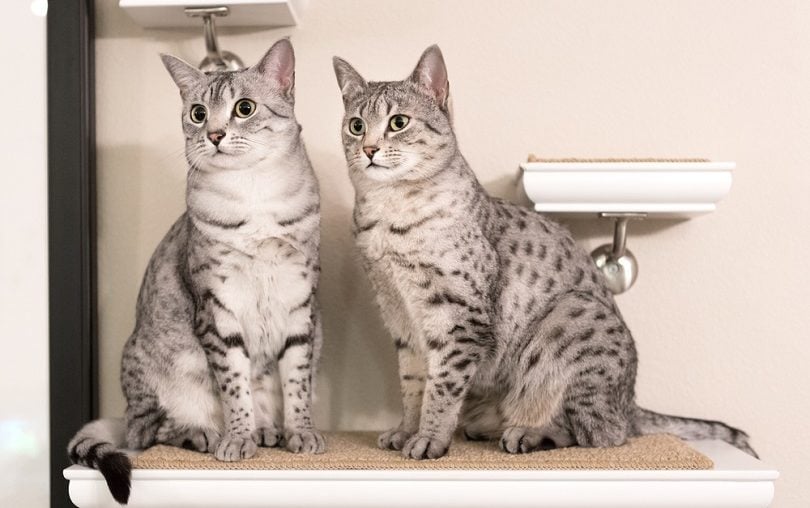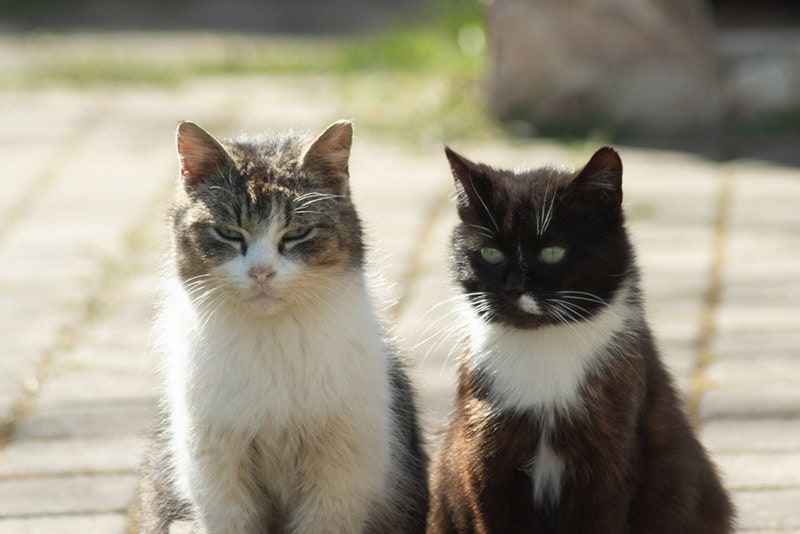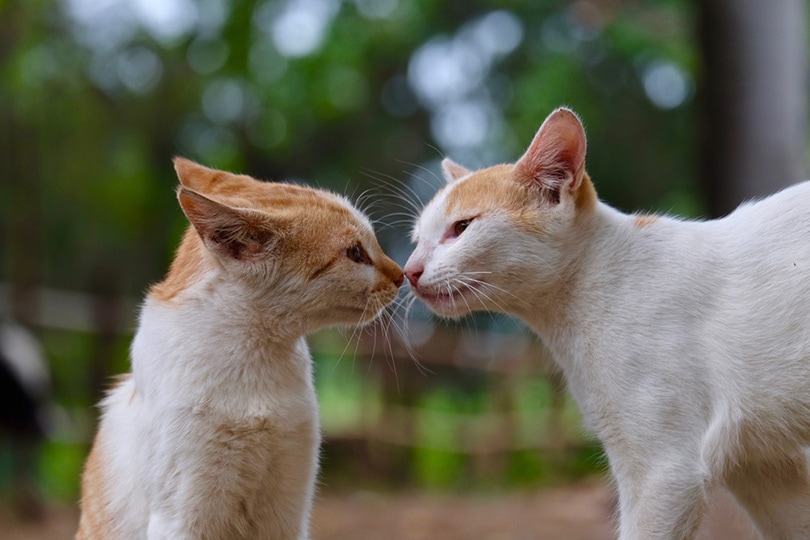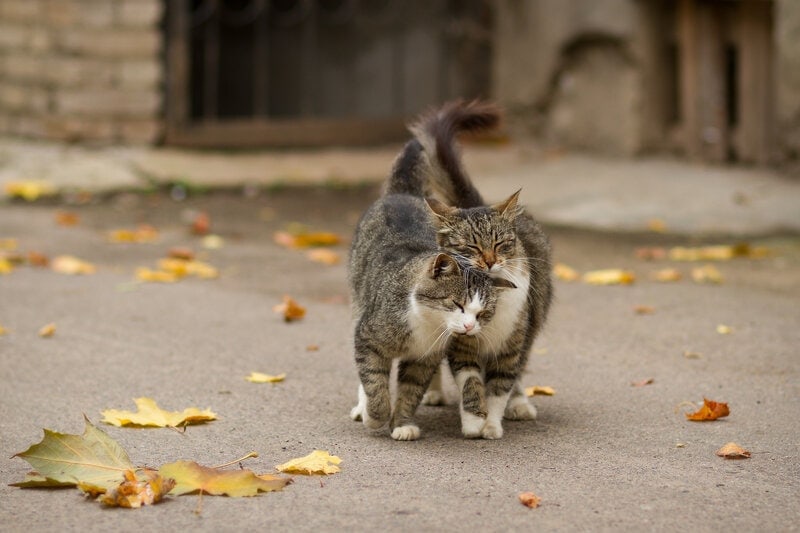
We need to distance ourselves from the human view of inbreeding to understand it from a biological perspective for cats. We must also consider evolution and its outcomes. Its aim is for organisms to live long enough to reproduce to pass on their genes. Technically, inbreeding satisfies this condition, so yes, cats do inbreed, even if it’s offensive to us. Felines may bond with each other, but they don’t necessarily comprehend relationships.
Humans are the wild card for this question. We have played a pivotal role in cats’ breeding by coordinating it. However, Mother Nature also has a dog in that race, which adds an interesting twist.
Cat Versus Dog Selective Breeding
The American Kennel Club (AKC) recognizes 197 dog breeds. In contrast, the International Cat Association (TICA) bestows that status on only 73 cat breeds. The difference lies in the animals’ roles and relationships with humans. Some dog breeds go back thousands of years. That’s a lot of time to selectively breed them for various jobs. Hence, we see different sizes and shapes of canines.
The history of cats and selective breeding is relatively short, only about 150 years. Most of the traits humans encouraged involved the animal’s appearance. Felines look quite similar compared to canines. Think of a Chinese Crested Dog versus a Bullmastiff. They couldn’t be more different on all scores. Selective breeding goes hand in hand with inbreeding for these very reasons.
It’s also worth mentioning the jobs dogs and cats fulfill for us. Canines can be hunting buddies, ratters, watchdogs, and herders. Felines do two things well: they either excel at keeping rodents under control, or they make delightful animal companions. Perhaps there aren’t as many breeds because people didn’t feel motivated to change something that works. After all, if it isn’t broken, don’t fix it, right?

Cat Breeding in the Wild
Wild felines are a different story. Without humans calling the shots, survival could assume its role as the major influence on evolution. One study compared populations of stray or feral cats and household animals.1 Genetic analyses of the two groups yielded compelling results.
The researchers found that disease resistance and environmental adaptations were the main drivers of evolution in stray cats. It makes sense since these responses would improve survival and, thus, the passage of DNA to the next generation. There wasn’t any conscious selection of prospective mates. Instead, survival of the fittest took its natural course.
Remember that selective breeding has different goals, some in direct opposition to evolution. For example, the flattened face of Persians makes them brachycephalic animals with a higher risk of respiratory issues. That feature hardly helps their survival. Sadly, inbreeding is inherent in purebred animals. Part of the pressure comes from conforming to official standards.
Another study found a 16% kitten mortality rate in pedigreed animals versus those not of a particular bloodline.2 Difficult births or dystocia are another risk factor with selective breeding within a small population, like purebred felines. However, the problems of inbreeding go further than affecting the number of surviving offspring.

The Impacts of Inbreeding
Inbreeding fixes specific genetic traits in animals. It also creates a vicious circle that may exacerbate its consequences. Small litter size is one effect. Another factor is the growing demand for these feline breeds that arose from genetic mutations.
For example, the Persian is the fourth most popular cat breed. The impacts on the number of offspring can affect the supply and, consequently, affect the price of these animals.
Other documented effects of inbreeding include the so-called piggyback mutations. Some traits latch onto the ones that breeders want to encourage, sometimes with unexpected results. The Scottish Fold has a greater propensity for a form of arthritis called osteochondrodysplasia. Siamese may have crossed eyes. The underlying cause for these adverse effects involves the gene pool.

Coefficients of Relation and Coefficient of Inbreeding
You can think of DNA as an organism’s cookbook. Genes are the ingredients. Other factors that affect the various expressions of genes in offspring rest with the relationships that exist between the parents and their young. Inbreeding brings it down to a numbers game.
The coefficient of relation quantifies the amount of DNA shared between two individuals. Offspring have 50% of their DNA from their mothers and fathers. Each parent contributes one copy or allele for each gene. Therefore, the offspring has genetic material from both parents. Whether they express it visually is another wrinkle in genetics involving whether an allele is dominant or recessive.
The former requires only one copy in the pair to manifest itself. The latter will show visually if both copies are the recessive variation. Of course, not all traits depend on a single gene. More than one may affect its visual expression or phenotype. However, the effects of inbreeding are the same. It reduces genetic variability. That can be good for a desirable trait, but it may also affect unwanted characteristics.
The coefficient of inbreeding reflects the percentage of variability lost from certain pairings. It’s the proverbial double-edged sword. It’s good if it increases the chances of the offspring having a trait you want to encourage or fix. It’s another matter if it heightens the risk of undesirable hereditary and congenital conditions.
The former passes to the offspring via the genes of a parent. The latter involves some conditions developing after birth and later in life. Pre-breeding health screenings can help prevent the occurrence of either type by preventing them from persisting in the bloodline. It’s an excellent compromise for having purebred cats and preventing them from becoming problematic.

Final Thoughts
Left to their own devices, cats will inbreed with survival prevailing. It’s not a choice but a reflection of the availability of suitable mates. Structured inbreeding through selective breeding can heighten the risk of hereditary and congenital conditions by increasing the odds they will occur with lower genetic variation. Limiting the gene pool carries risks, whether it happens naturally or intentionally.
Featured Image Credit: Arina Krasnikova, Pexels






